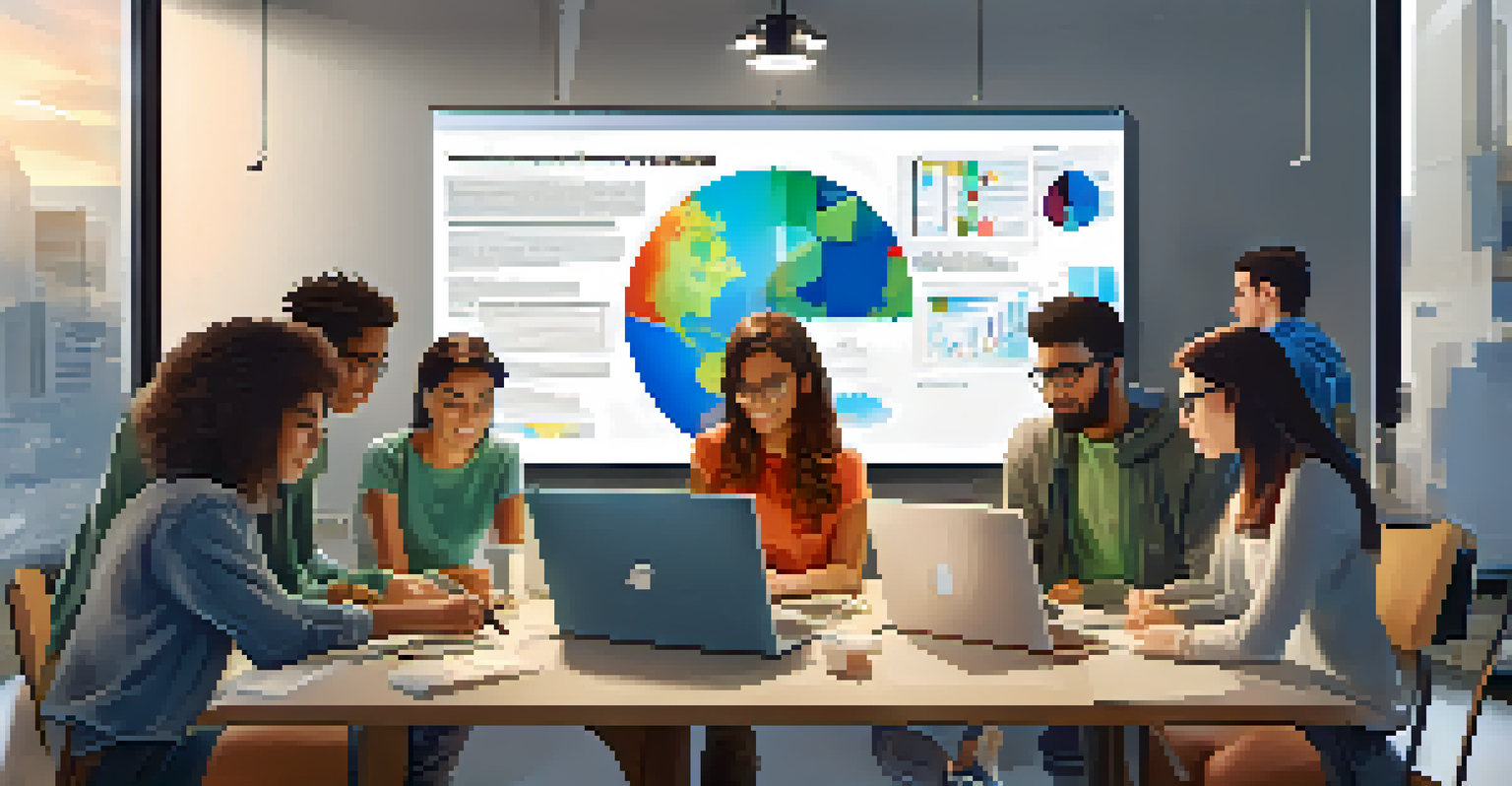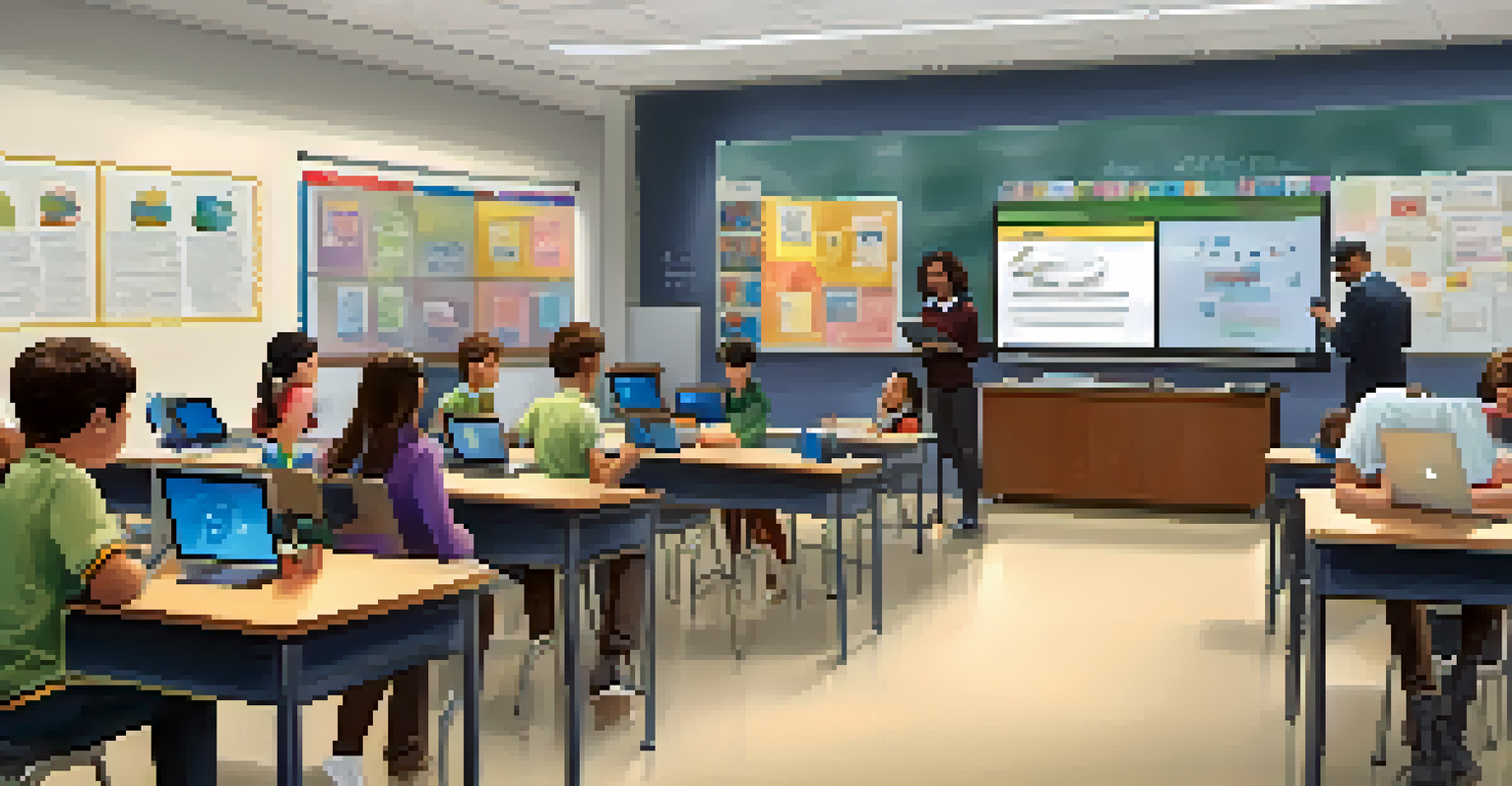Evaluating the Effectiveness of Transmedia Learning

Understanding Transmedia Learning in Education
Transmedia learning refers to educational experiences that unfold across multiple platforms, such as books, videos, and games. This approach allows students to engage with content in various formats, catering to different learning styles. For instance, a history lesson might include reading a textbook, watching a documentary, and playing an interactive video game. By integrating diverse media, transmedia learning can make complex topics more accessible and enjoyable for students.
Learning is not the product of teaching. Learning is the product of the activity of learners.
One key benefit of transmedia learning is its ability to foster deeper engagement. When learners encounter the same content through different mediums, they are more likely to make connections and retain information. Imagine a student studying a science concept through a video, followed by a hands-on experiment, and then a podcast discussing real-world applications. This multi-faceted approach not only reinforces learning but also encourages critical thinking and creativity.
However, implementing transmedia learning effectively requires careful planning and coordination. Educators need to ensure that each medium complements the others and that the overall learning objectives are clear. Without a cohesive strategy, students might feel overwhelmed or confused by the variety of formats. Therefore, it’s essential to evaluate how each component contributes to the learning experience.
The Role of Technology in Transmedia Learning
Technology plays a pivotal role in facilitating transmedia learning experiences. Digital platforms allow educators to create and share content easily, reaching students in innovative ways. For instance, online forums, social media, and interactive apps can enhance collaboration among learners, making them active participants in their education. This interconnectedness can lead to a more community-driven learning atmosphere.

Moreover, technology can offer personalized learning paths, catering to individual student needs. With the help of analytics, educators can track student progress and adapt content accordingly. Imagine a student struggling with a concept in a video game; the system could suggest supplementary materials or alternative formats to reinforce their understanding. This adaptability is one of the significant advantages of transmedia learning.
Engagement Boosts Learning Retention
Transmedia learning enhances student engagement by providing diverse formats, leading to better retention of information.
However, it’s essential to ensure that technology enhances rather than detracts from the learning process. Over-reliance on digital media can lead to distractions, making it difficult for students to focus. Therefore, striking the right balance between technology and traditional learning methods is crucial for achieving educational goals.
Assessing Learner Engagement in Transmedia Learning
Engagement is a critical factor when evaluating the effectiveness of transmedia learning. Active participation in various formats can indicate that students are invested in their learning process. Educators can assess engagement through observations, surveys, and feedback from students about their experiences across different media. For example, asking students to share their thoughts on a documentary versus a hands-on project can provide valuable insights.
The future of education is not about the technology. It's about the learning experiences we create.
In addition to qualitative assessments, quantitative metrics can also be helpful. Tracking completion rates, participation in discussions, and performance on assessments can offer a clearer picture of how engaged learners are. When students are immersed in a transmedia learning environment, they often exhibit increased motivation, which can translate into better academic outcomes.
However, it’s important to recognize that engagement alone doesn't guarantee understanding. Educators should also focus on evaluating whether students can apply what they’ve learned across different contexts. This holistic approach to assessment ensures that engagement leads to meaningful learning experiences.
Measuring Knowledge Retention in Transmedia Learning
Knowledge retention is another crucial aspect to consider when evaluating transmedia learning effectiveness. The goal is not just for students to learn new information but to remember and apply it long-term. Research suggests that engaging with content across multiple formats can enhance retention, as it allows learners to revisit and reinforce their understanding. For example, a student who reads about an ecological issue, watches a related documentary, and participates in a discussion group may retain the information better than through a single format.
To effectively measure knowledge retention, educators can use a variety of assessment techniques. Pre- and post-tests can provide insights into what students have learned over time. Additionally, incorporating reflective practices, such as journals or portfolios, allows students to articulate their understanding, further solidifying their knowledge. These methods can highlight the effectiveness of transmedia learning in promoting long-lasting educational outcomes.
Technology Enhances Learning Experience
The integration of technology in transmedia learning allows for personalized learning paths and improved collaboration among students.
Nonetheless, educators should be aware that retention can vary among students. Factors such as individual learning styles, prior knowledge, and personal interest in the subject matter can influence how well students retain information. Therefore, a tailored approach that considers these variables is essential for maximizing the benefits of transmedia learning.
The Impact of Collaboration in Transmedia Learning
Collaboration is a vital component of transmedia learning, as it encourages students to work together across different platforms. Group projects that integrate various media can foster teamwork and communication skills, preparing students for real-world scenarios. For example, a group might create a multimedia presentation that combines video clips, infographics, and written reports, showcasing their understanding of a particular topic.
Working collaboratively can also enhance creativity, as diverse perspectives contribute to richer ideas and solutions. When students share their thoughts and insights through different media, they can build on each other's strengths. This collective approach not only deepens understanding but also creates a sense of community and belonging among learners.
However, effective collaboration requires clear guidelines and roles to ensure that all group members contribute meaningfully. Educators should provide structures to facilitate cooperation, such as assigning specific tasks or using collaborative tools. By fostering a supportive environment, educators can maximize the benefits of collaboration in transmedia learning.
Challenges and Limitations of Transmedia Learning
While transmedia learning offers numerous benefits, it also comes with challenges and limitations. One major hurdle is the potential for information overload, where students may struggle to process and integrate content from multiple sources. This can lead to confusion and frustration, undermining the learning experience. Therefore, educators must carefully curate materials and provide clear pathways for exploration.
Additionally, not all students may have equal access to the required technology. Disparities in resources can create inequities in learning opportunities, making it essential for educators to consider how to address these gaps. Offering alternative formats or resources can help ensure that all students have a fair chance to engage with the content.
Collaboration Fosters Community Growth
Collaborative projects in transmedia learning encourage teamwork and creativity, enriching the educational experience.
Lastly, educators may face difficulties in assessing the effectiveness of transmedia learning. With various formats and individual learning paths, it can be challenging to measure success consistently. Developing a comprehensive evaluation framework that accounts for different media and learning styles is necessary for accurately gauging the impact of transmedia learning.
Future Directions for Transmedia Learning Evaluation
Looking ahead, the evaluation of transmedia learning will likely evolve as technology and educational practices continue to advance. Emerging technologies, such as virtual reality (VR) and augmented reality (AR), may offer new opportunities for immersive learning experiences. Educators will need to explore how these innovations can be integrated into transmedia strategies and assess their effectiveness in enhancing student engagement and understanding.
Moreover, as the landscape of education changes, there will be a growing emphasis on personalized learning experiences. Evaluating how transmedia learning can cater to individual student needs will be crucial in ensuring that all learners benefit from diverse educational approaches. This might involve adaptive learning technologies that respond to students' progress and preferences.

Ultimately, the goal of evaluating transmedia learning is to create more effective and inclusive educational environments. By continuously assessing the impact of different media and approaches, educators can refine their strategies and provide students with the best possible learning experiences. This ongoing evaluation process will be key to unlocking the full potential of transmedia learning in the future.